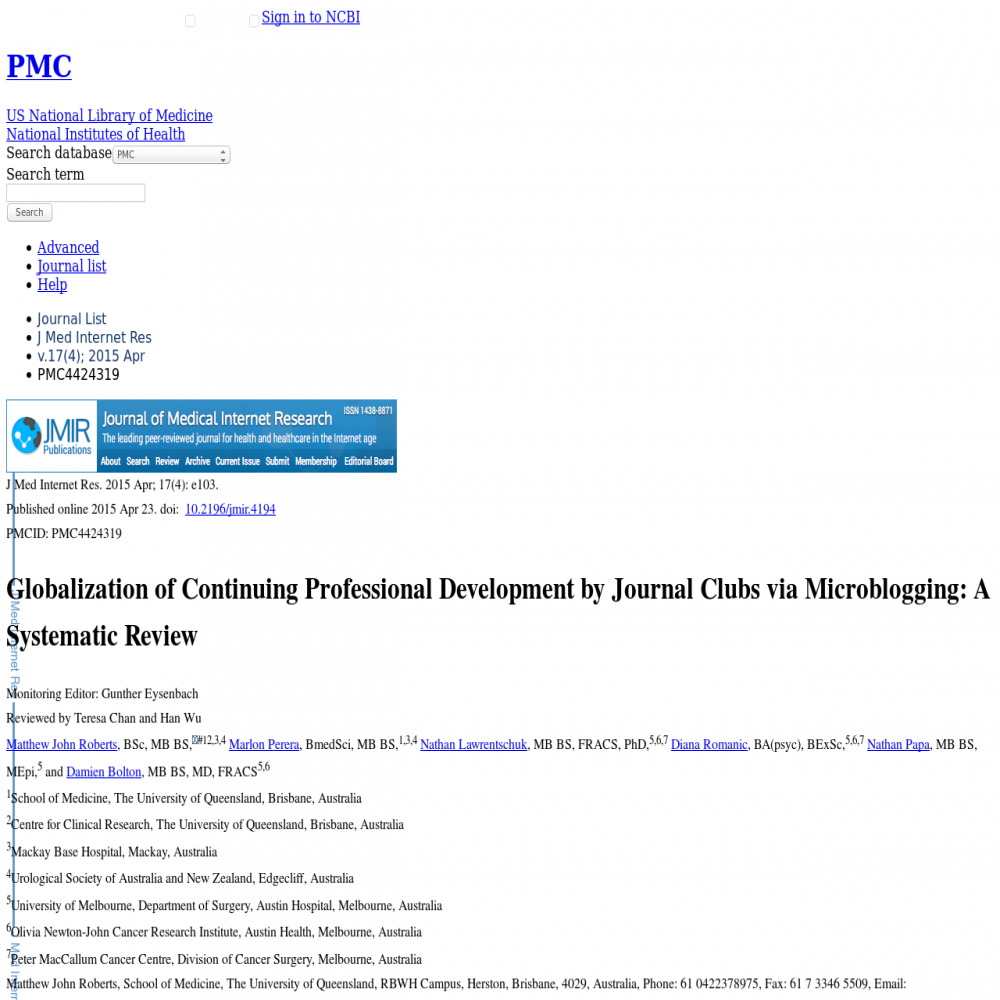Globalization of Continuing Professional Development by Journal Clubs via Microblogging: A Systematic Review
A healthcare social media research article published in Journal of Medical Internet Research, April 23, 2015
- Title
- Globalization of Continuing Professional Development by Journal Clubs via Microblogging: A Systematic Review
- Authors (alpha)
- Damien Bolton, Diana Romanic, Marlon Perera, Matthew John Roberts, Nathan Lawrentschuk, Nathan Papa
- Published
- April 23, 2015
- Journal
- Journal of Medical Internet Research
- Impact Factor
- 5.835
- DOI
- 10.2196/jmir.4194
- Pubmed
- 25908092
- Altmetric
Abstract
Journal clubs are an essential tool in promoting clinical evidence-based medical education to all medical and allied health professionals. Twitter represents a public, microblogging forum that can facilitate traditional journal club requirements, while also reaching a global audience, and participation for discussion with study authors and colleagues. The aim of the current study was to evaluate the current state of social media-facilitated journal clubs, specifically Twitter, as an example of continuing professional development. A systematic review of literature databases (Medline, Embase, CINAHL, Web of Science, ERIC via ProQuest) was performed according to Preferred Reporting Items for Systematic Reviews and Meta-Analyses (PRISMA) guidelines. A systematic search of Twitter, the followers of identified journal clubs, and Symplur was also performed. Demographic and monthly tweet data were extracted from Twitter and Symplur. All manuscripts related to Twitter-based journal clubs were included. Statistical analyses were performed in MS Excel and STATA. From a total of 469 citations, 11 manuscripts were included and referred to five Twitter-based journal clubs (#ALiEMJC, #BlueJC, #ebnjc, #urojc, #meded). A Twitter-based journal club search yielded 34 potential hashtags/accounts, of which 24 were included in the final analysis. The median duration of activity was 11.75 (interquartile range [IQR] 19.9, SD 10.9) months, with 7 now inactive. The median number of followers and participants was 374 (IQR 574) and 157 (IQR 272), respectively. An overall increasing establishment of active Twitter-based journal clubs was observed, resulting in an exponential increase in total cumulative tweets (R(2)=.98), and tweets per month (R(2)=.72). Cumulative tweets for specific journal clubs increased linearly, with @ADC_JC, @EBNursingBMJ, @igsjc, @iurojc, and @NephJC, and showing greatest rate of change, as well as total impressions per month since establishment. An average of two tweets per month was estimated for the majority of participants, while the "Top 10" tweeters for @iurojc showed a significantly lower contribution to overall tweets for each month (P<.005). A linearly increasing impression:tweet ratio was observed for the top five journal clubs. Twitter-based journal clubs are free, time-efficient, and publicly accessible means to facilitate international discussions regarding clinically important evidence-based research.
Altmetric
The Altmetric Attention Score is based on the attention a research article gets on the internet. Each coloured thread in the circle represents a different type of online attention and the number in the centre is the Altmetric Attention Score. The score is calculated based on two main sources of online attention: social media and mainstream news media.
Healthcare Social Media Research
See the full list of healthcare social media research articles with data from or reference to Symplur.
#hcsmR is a collaboration between Stanford Medicine X and Symplur.


